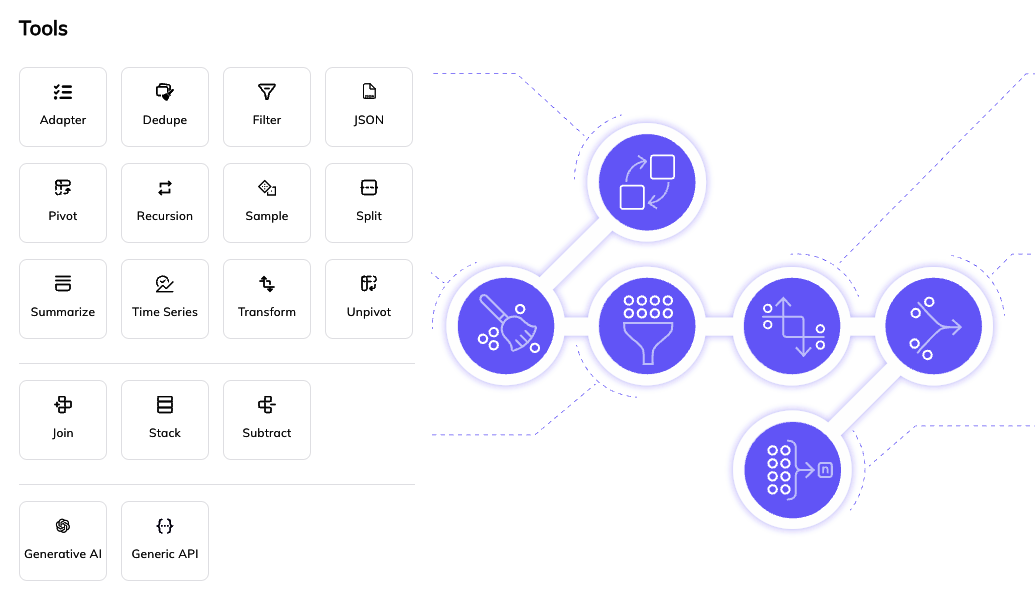Putting an End to the Monotony of Manual Analytics
Every organization’s number one priority when it comes to business analytics is to answer more questions with data faster. We’ve all heard this for a long time. Yet, even today, analyst teams struggle with manual data wrangling, resorting back to Excel, struggling with accessing data from modern SaaS apps and even modern data platforms.
Specialized skill requirements result in different teams with varying skill sets all jumping in and a series of hand-offs to arrive at analytics outcomes that meet the bar of business stakeholders. But regardless of the hands-offs and complexities, digital competitiveness is driving every organization to find a way to deliver analytic insights faster. The only way around this is to automate analytics processes end-to-end, from data access to insights, and reduce the dependency on manual iterations.
Automating manual data tasks and repetitive processes has become paramount for organizations. Becoming data-driven and eliminating the mundane has driven organizations to prioritize investments in analytics solutions that are easy to use and have built-in automation. Organizations that have adopted modern analytics solutions that are also powered by generative AI have successfully enabled analysts, with no special skills required, to achieve 5x faster analytics–across finance, sales, marketing, supply chain, product, and customer analytics.
Hundreds to thousands of hours of manual work have been eliminated. Moreover, generative AI-powered analytics tools make it possible for all analysts and business users to create analytics outcomes without needing specialized skill sets. The ability to craft a prompt to access data from a source, write a prompt specifying how to prep the data, and even use generative AI to create analytics logic is a ground-breaking advancement. Together with a platform that is inherently built for automation, the two combined are delivering 5x and great analyst productivity and speed to outcomes.
Read on to learn more about the five key requirements for faster analytical results.
1. A Purpose-built Analytics Automation Solution for Business and Data Analysts
Analytics and AI solutions to date are built for business intelligence (BI) and data engineers, requiring specialized skills in building and operating data integration, analytics, and automation pipelines. Modern organizations are realizing that it is not a scalable approach for the following reasons:
- There aren’t enough data and BI engineers to support the ever-increasing demand for analytics.
- There are only 7M structured query language (SQL) engineers worldwide, creating a massive gap between supply and demand.
- There are 60M+ people using Excel for analytics!
- Engineers often lack business context to build analytic solutions, leading to days and weeks of back-and-forth hand-offs and discussions with business teams to learn and document what they need resulting in delays and frustration on both sides.
Modern leaders recognize that providing data analysts with self-service automation tools is the best way to achieve analytics with speed and agility.
A new type of analytics automation purpose-built for modern data stacks and business applications combined with generative AI has proven to support the shift–from pulling data directly from hundreds of apps and databases – both on-prem and in the cloud. These tools allow business teams to use a drag-and-drop intuitive interface to create an analytics workflow where the workflow includes all the functions to prep and blend data, run analytics, and then deliver insights as alerts into any business app, BI dashboard, or even notify of anomalies in insights directly to Slack, email, Teams, chat, and more. The workflow itself requires no coding – but rather, analysts select from a palette of widgets to prep and transform data, insert analytics logic, and set up insights to be published on an automated schedule to a destination of choice.
Now, with platforms that provide the drag-and-drop automation widgets for every step of the analytics process and generative AI capabilities fused in, analysts can now significantly speed every step of the process from data access, to prep and transformation, to analytics logic and calculations, to setting up automated delivery of insights on a schedule. The figure below shows the progression of analytics solutions. The key drivers for rapid innovation have been a) the need to empower more people without specialized skills to perform self-service analytics, b) the need to access data from modern stacks, and c) the need to scale at low costs by using modern cloud-native solutions.

Automation solutions that also support generative AI for data access, data cleaning, data prep and blending, analytics logic, and delivery of insights can boost analyst productivity by over 40%. By simply using natural language prompts, now anyone can be a self-service analyst. An example of its simplicity for data prep is shown below.

2. One-click Data Access & Processing from Modern Data Sources
Most analytics tools claim easy data access. However, in practice, organizations run into three common limitations, ultimately limiting the speed, agility, and impactfulness of AI and analytics.
These limitations include:
- Cloud data connectivity and speed of processing: connectors typically have limitations when it comes to connecting with various SaaS business applications, such as ERP systems, HR systems, CRM systems, and more. Establishing connectivity with cloud-based data warehouses or modern data lakes often requires a complex setup, delaying achieving analytic insights. This repetitive cycle of dependencies on IT and data engineers hinders data updates.
- Curating data from multiple diverse sources: for most analytics use cases, a subset of data is required from multiple files, data platforms, and business applications. However, most analytics tools are designed to copy or replicate data to create analytics-ready datasets, creating a host of challenges–large volumes of unnecessary data transfers and storage and the need for experts to write scripts, which creates data security and governance risks.
- Speed and scale of data processing: in many instances, legacy tools have limitations on handling large data volumes–they’re slow to process high volumes of data or data that frequently updates. They also lack support for unstructured data such as JavaScript Object Notation (JSON), nested data, the internet of things (IoT), clickstream data, and so forth, resulting in even more data processing complexity.
Modern analytics automation solutions can connect to hundreds of data sources and applications with just a few clicks, including easily handling both structured and unstructured data. This enables analysts to access data from any source without burdening IT or data teams.
Cloud-native architectures auto-scale to large data volumes, workflows, and users compared to previous-generation tools – and new modern architectures do so at 50%+ lower costs. They are only a click away and can handle structured and unstructured data. These modern architectures can handle large data volumes and accelerate data processing while being compute-efficient, so connecting to many sources and high data volumes is more cost-efficient.

3. Automate End-to-End Analytics with Drag-and-Drop Visual Workflows and Generative AI
Analytics development is a workflow that orchestrates data from multiple sources, and executes required business logic to produce analytics and enables collaboration between various stakeholders. In many cases, the workflow must be reviewed, approved, and audited, ensuring data governance and compliance. Lastly, the workflow needs to be automated, meet service level agreements (SLAs), and have proactive alerts and remediation tools in case of errors in the workflow.
Most BI and analytics tools, however, do not enable a workflow-driven approach to analytics development and were never built for reliable automation, severely limiting the speed and scale of analytics for critical business processes. Modern solutions provide a drag-and-drop workflow-driven approach to automate analytics from the point of accessing data to data prep, transformation, data blending, business logic, and delivery of insights.

Every step of the analytics process is enabled via drag-and-drop widgets and functions, making it possible to orchestrate, build, and automate without writing code. Add to that generative AI as a means to accelerate analytics even more by simply entering a prompt. Now, the user doesn’t need to know how to customize a function or widget but rather have a generative AI prompt drive the underlying automation. Generative AI can simplify data access, data prep, data blending, creation of analytics logic and interpretation of insights. Here are some specific examples of the power of generative AI-powered analytics automation solutions.


Cloud-native analytics automation platforms also make it possible to share workflows without the hassle of uploading them from laptops to servers. Built-in documentation & collaboration capabilities make it possible for other users to make updates and maintain the analytics in the event the author of the analytic workflow is not available. Finally, reusing analytics workflows and leveraging pre-built templates make it possible to expedite the creation of new analytic workflows quickly.

These solutions also have state-of-the-art automation capabilities–from scheduling and triggering workflows to bot-driven data access and delivery to proactive alerts for data errors and tools to remediate them.
Each workflow execution is automatically captured, visualized, and auto-documented, making it easy to audit and comply with data security standards, regulations, and ensure governance.
4. Deliver Automated Insights to Business Stakeholders Directly into their Business Apps
Visualizing data in dashboards is good for tracking business key performance indicators (KPIs) but not for operational analytics and driving day-to-day decisions. Modern analytics automation solutions enable insights or data to be delivered to multiple apps or BI dashboards in parallel, where each can be set to a different update schedule. Further, such solutions also leverage built-in Bots to both automate the delivery of insights and track exceptions that trigger notifications in the app of choice. For that, business users and teams want alerts and notifications sent directly to the business apps and communication channels (e.g., email, Slack, Microsoft Teams, etc.) they regularly use.
Built-in operational capabilities ensure data and insights delivery meets SLAs. If reports or insights delivery encounters a failure (e.g., the report cannot be delivered because the destination app or BI tools credentials have expired), then analysts are notified immediately to take action, and the tools assist with auto-remediation.

5. Invest in a Cloud-Native Automation Solution and Scale at 50% Lower Costs
Runway infrastructure costs and lack of data governance are two major inhibitors for IT teams when it comes to scaling analytics. As more users within organizations adopt self-service analytics and more analytic workflows are developed, the volume of data processing grows exponentially. As a result, the infrastructure cost of licensing, provisioning, and maintaining servers grows exponentially without notice. Data governance gets out of hand with more users downloading data on their laptops to run analytics.
Modern AI and analytics solutions liberate IT teams from both problems. First, the cloud-native platforms auto-scale with users, analytic workflows, and data processing volume. No need to buy more server licenses and maintain complex IT infrastructure. Second, the cloud-native approach makes it possible to govern data access and delivery from one centralized platform.
These modern analytics solutions are designed to scale on every dimension while reducing an organization’s total cost of ownership (TCO) by more than 50% over generation I and II solutions.
Summary
A unified analytics automation platform infused with generative AI capabilities that provides all 5 key requirements will speed analytics and outcomes by 5x-10x while empowering analysts to create, manage, and iterate analytic workflows without dependencies on IT or data engineers. As organizations need to access an average of 5-7 data sources per analysis and deliver hourly or up-to-the-minute accurate insights in the business users’ app of choice, adopting a modern analytics automation solution has become paramount. To hear how one company automated analytics across all their business units, tune in to this video and hear from the Chief Operating Office of Million Dollar Baby, a global manufacturer of children's furniture. See analytics automation in action and the power of generative AI. Experience Savant Anaytics Automation in minutes. Get your Free Trial here or Request a Demo.











